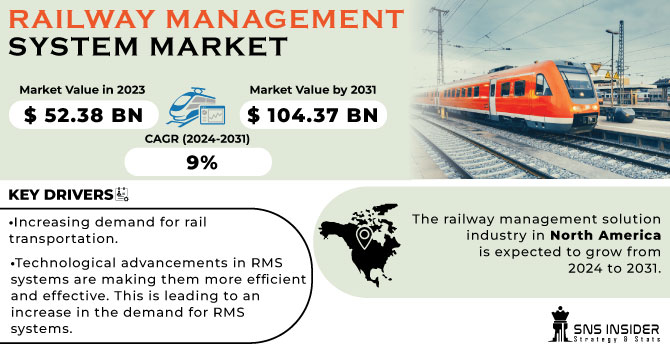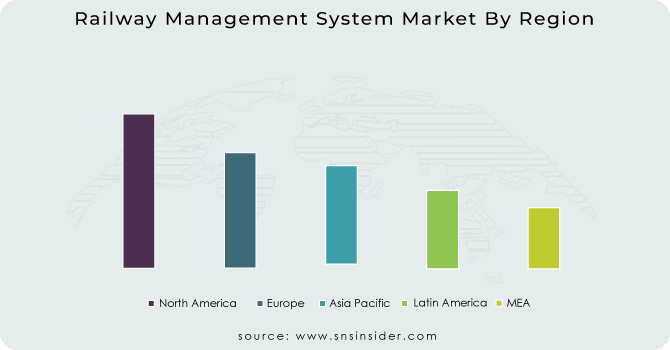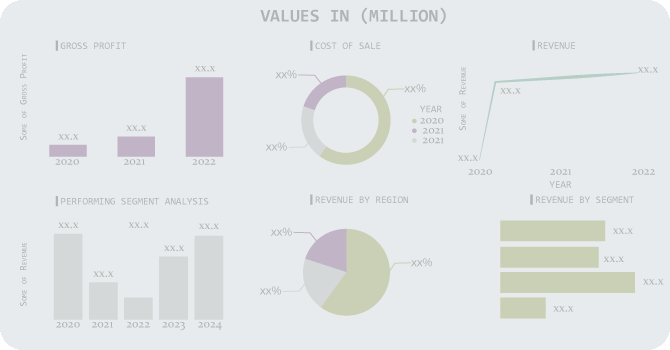Railway Management System Market Report Scope & Overview
The Railway Management System Market size was USD 52.38 billion in 2023 and is expected to Reach USD 104.37 billion by 2031 and grow at a CAGR of 9% over the forecast period of 2024-2031.
The Railway Management System Market is growing due to a surge in factors like improved service performance, efficient train operation management, and travel promotion. These systems, encompassing both manual and automated solutions, streamline various railway operations like scheduling, traffic control, and infrastructure upkeep. Essentially, they track a train's entire journey, from departing the shed to reaching its destination. By providing a clear picture of operational performance, railway management systems empower decision-makers to balance complex demands like track access and crew resources. They achieve this through features like traffic management for improved service, infrastructure optimization, automated tasks for reduced workload, and optimized energy consumption for passenger comfort. Ultimately, these systems enhance customer satisfaction by minimizing delays and ensuring adherence to schedules, leading to increased freight and passenger capacity. With faster problem prediction, simulation, and resolution, railway management systems are poised to drive significant market growth in the coming years.

Get More Information on Railway Management System Market - Request Sample Report
MARKET DYNAMICS:
KEY DRIVERS:
-
Railway digitalization is accelerating due to technological advancements, promising revenue growth, cost reduction, and improved passenger experiences.
The rapid digitalization offers major benefits for both railway companies and passengers. It allows for innovative services, improved operational efficiency, and lower costs. Railways are embracing these digital solutions, moving away from traditional methods. As a key element of sustainable urban growth, efficient railway systems are crucial. This focus on digital transformation is expected to significantly drive market growth in the railway management system sector.
RESTRAINTS:
-
Complexities Hinder Railway Management System Growth
The railway technology management systems offers a powerful integration of hardware, software, and networks but complexity can act as a barrier to market growth. Merging different hardware with existing infrastructure and software can be challenging, further hampered by compatibility issues between legacy systems and modern smart devices. This communication gap between older and newer technologies creates hurdles for seamless integration, potentially hindering the market's expansion in the coming years.
OPPORTUNITIES:
-
Development of robust cybersecurity solutions will ensure the safety and reliability of increasingly digitalized railway operations.
-
Implementing AI-powered predictive maintenance systems can prevent equipment failures and optimize resource allocation.
CHALLENGES:
-
Compatibility problems between older and modern technologies can hinder seamless communication within the railway management system.
-
Adapting existing railway facilities to accommodate advanced management systems can be expensive and disruptive.
IMPACT OF RUSSIA-UKRAINE WAR
The war in Russia-Ukraine has significantly disrupted the Railway Management System Market. Global supply chains are in mess, hindering production and delivery of crucial hardware components, potentially causing project delays and inflating costs by up to 10% in the short term. It may also raise cybersecurity concerns, with potential cyberattacks targeting critical railway infrastructure and causing disruptions that could lead to financial losses and reputational damage. Sanctions on Russia might limit access to specific technologies or expertise, impacting railway operators' options in terms of market share for Russian providers. Rising energy prices are driving up operational costs for railways, potentially leading to budget cuts or delays in investments for railway management system upgrades.
IMPACT OF ECONOMIC SLOWDOWN
An economic slowdown can disrupt the Railway Management System Market. Limited budgets across industries, including railways, can lead to delays or cancellations of upgrades to infrastructure and management systems, potentially causing a 5-10% decrease in market growth rate. Reduced economic activity also translates to a decline in both freight and passenger rail traffic. This translates to decrease in demand for freight and passenger management systems, as businesses reduce production and transportation needs, and consumer spending on travel dips. The railway operators prioritize essential maintenance over implementing new technologies when faced with budget constraints, hindering the market growth for cutting-edge systems. Economic uncertainty fosters risk among investors, potentially discouraging investments in new railway projects or innovative management systems.
KEY MARKET SEGMENTS:
By Offering
-
Solutions
-
Rail Operations Management
-
Rail Traffic Management
-
Signalling Solutions
-
Real-Time Train Planning and Route Scheduling/Optimizing
-
Centralized Traffic Control
-
Positive Train Control
-
Rail Communications-Based Train Control (CBTC)
-
Other Traffic Management Solutions
-
-
Asset Management
-
Enterprise Asset Management
-
Field Service Management
-
Asset Performance Management
-
Other Asset Management Systems
-
-
Intelligent In-Train Solutions
-
Other Solutions
-
-
Services
-
Consulting Services
-
System Integration and Deployment Services
-
Support And Maintenance Services
-
Rail Operations Management is the dominating sub-segment in the Railway Management System Market by offering. This is because it directly addresses the core needs of railway operators to improve efficiency, optimize resource allocation, and ensure on-time performance. Rail Operations Management solutions provide features like Crew and resource scheduling, Yard management, Fuel management, Network optimization which directly impact the profitability and competitiveness of railway companies, making Rail Operations Management a critical investment.
Support and Maintenance Services is the dominating sub-segment in the Railway Management System Market by offering. This dominance is due to the increasing complexity of railway management systems. These services ensure the smooth functioning and optimal performance of the system by providing System monitoring and troubleshooting, Helpdesk support, Software updates and upgrades. Thus, without ongoing support and maintenance, railway management systems can become outdated, unreliable, and potentially unsafe.
Region Coverage:
North America
-
USA
-
Canada
-
Mexico
Europe
-
Eastern Europe
-
Poland
-
Romania
-
Hungary
-
Turkey
-
Rest of Eastern Europe
-
-
Western Europe
-
Germany
-
France
-
UK
-
Italy
-
Spain
-
Netherlands
-
Switzerland
-
Austria
-
Rest of Western Europe
-
Asia Pacific
-
China
-
India
-
Japan
-
South Korea
-
Vietnam
-
Singapore
-
Australia
-
Rest of Asia Pacific
Middle East & Africa
-
Middle East
-
UAE
-
Egypt
-
Saudi Arabia
-
Qatar
-
Rest of the Middle East
-
-
Africa
-
Nigeria
-
South Africa
-
Rest of Africa
-
Latin America
-
Brazil
-
Argentina
-
Colombia
-
Rest of Latin America
REGIONAL ANALYSES
The Asia Pacific is the dominating region in the Railway Management System Market holding around 40-45% of market share, fueled by growing infrastructure development fueled by government initiatives. Rising disposable income in the region further translates to increased passenger and freight traffic, demanding ever more efficient management systems.
North America is the second highest region in this market, driven by a strong focus on adopting advanced technologies and a well-established railway infrastructure that readily integrates new systems. It boasts a robust freight rail sector, creating a significant market for efficient freight management solutions.

Need any customization research on Railway Management System Market - Enquiry Now
KEY PLAYERS
The major key players are Indra Sistemas, Computer Sciences Corporation, GE Transportation, ABB Ltd., Ansaldo STS, Hitachi Ltd., Alstom, IBM Corporation, Bombardier Inc., Thales and other key players.
Indra Sistemas-Company Financial Analysis

RECENT DEVELOPMENT
-
In March 2024: Siemens expands its partnership with Metrolinx to handle track, signal, and right-of-way maintenance for Toronto's central passenger railway system, adding to its existing services in the west and network operations centre.
-
In March 2024: Hitachi Rail launches Train Maintenance DX as a Service, the industry's first subscription-based solution for improved train maintenance quality and work environment, leveraging their digital manufacturing expertise.
-
In Feb. 2024: Alstom signed a deal to maintain PKP Polskie Linie Kolejowe's railway traffic control systems, including track vacancy and power supply, across 328 facilities in Poland.
| Report Attributes | Details |
| Market Size in 2023 | US$ 52.38 Bn |
| Market Size by 2031 | US$ 104.37 Bn |
| CAGR | CAGR of 9% From 2024 to 2031 |
| Base Year | 2023 |
| Forecast Period | 2024-2031 |
| Historical Data | 2020-2022 |
| Report Scope & Coverage | Market Size, Segments Analysis, Competitive Landscape, Regional Analysis, DROC & SWOT Analysis, Forecast Outlook |
| Key Segments | • By Offering (Solutions [Rail Operations Management, Rail Traffic Management, Asset Management, Intelligent In-Train Solutions, Other Solutions], Services) |
| Regional Analysis/Coverage | North America (US, Canada, Mexico), Europe (Eastern Europe [Poland, Romania, Hungary, Turkey, Rest of Eastern Europe] Western Europe] Germany, France, UK, Italy, Spain, Netherlands, Switzerland, Austria, Rest of Western Europe]), Asia Pacific (China, India, Japan, South Korea, Vietnam, Singapore, Australia, Rest of Asia Pacific), Middle East & Africa (Middle East [UAE, Egypt, Saudi Arabia, Qatar, Rest of Middle East], Africa [Nigeria, South Africa, Rest of Africa], Latin America (Brazil, Argentina, Colombia Rest of Latin America) |
| Company Profiles | Indra Sistemas, Computer Sciences Corporation, GE Transportation, ABB Ltd., Ansaldo STS, Hitachi Ltd., Alstom, IBM Corporation, Bombardier Inc., Thales |
| Key Drivers | • Increasing demand for rail transportation • Technological advancements in RMS systems are making them more efficient and effective. This is leading to an increase in the demand for RMS systems. |
| Market Restraints | • Data privacy concerns • The expansion of the market may be hampered by rising passenger and freight traffic |

